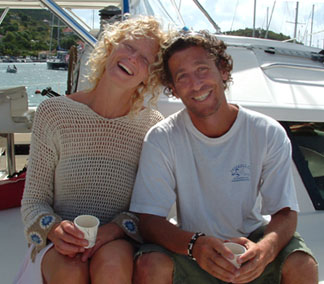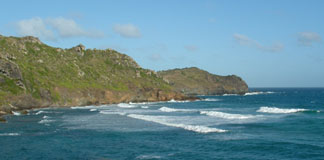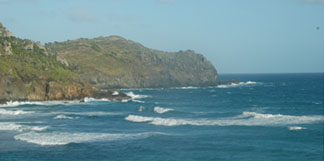 |
Big Change for Tom Conerly of Santa CruzJanuary 10 - St. Barth, FWI While walking down the dock in St. Barth's only port, a couple of days before New Year's, we bumped into Tom Conerly of Santa Cruz. Talk about a guy who has made a big change! For a quarter of a century, most of his sailing had consisted of racing on Moore 24s, one of the smallest 24-footers around. Down in Santa Cruz, he raced his own Wildfire, and when on the Bay, he skippered the St. Francis YC-based Snafu-U. For coastal races, TransPacs, and West Marine Pacific Cups, he raced aboard larger monohulls such as Santa Cruz 50s. 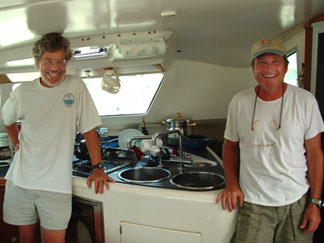 Tom Conerly and David Lewis Conerly's sailing life changed dramatically last year when he and David Lewis of Massachusetts became boat partners in HaPai, a F/P 42-ft Venezia cruising cat they'd bought in a liquidation sale in Fort Lauderdale. "I'm a recovering racer," Conerly admits. And the recovery doesn't seem to be that hard. "I like sailing on the cat. Instead of it being 'camping with the boys' like on the Moore 24, with the cat you get your own big cabin, a big salon with 360 degree visibility and standing headroom, and a huge cockpit. It's a great platform for being on the ocean. In fact, I can't even imagine going cruising on a monohull." 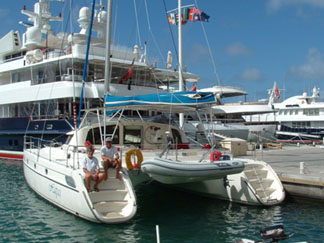 HaPai, and some other big yachts Photos Latitude/Richard Although Conerly's first catamaran experience was aboard a Lagoon 42 on a charter with his family, they are not cruising with him. "My wife is not a sailor, so she flies into the places she likes, and my kids are grown now." It's the same with boat partner Lewis, who flies in to meet him at selected places. For a guy who had raced Moore 24s for 25 years, we were surprised to learn that when looking for boats Conerly didn't care at all about the boat's sailing characteristics. An architect on sabbatical, he was primarily interested in the use of space on various cats. The Venezia is considered to offer the performance typical of French cats built for the charter trade, which means they don't point particularly high because they don't have daggerboards, and they don't sparkle in light air because they have modest sail area. But Conerly reports that given the right conditions, HaPai gets up and goes. "On our way down from Massachusetts to the Caribbean, we had a period of 30-knot winds with 12-ft seas, and we were doing 12 to 14 knots with a reefed main and a small jib. This resulted in a lot of pounding, however, so we double-reefed the main and slowed down to 8 to 10 knots. I have a tendency to keep too much sail up, but have to shorten down in order for the autopilot to handle the boat." After buying the boat in Lauderdale last year, Conerly and Lewis put in a lot of time fixing her up, then had an even better time taking her up the East Coast to Massachusetts. "We hung around Annapolis for a while, then got a berth for just $10/night at the 79th Street Boat Basin in New York City, where we were right next to Roman Abramovich's 350-ft Le Grand Bleu. It was even fun on the IntraCoastal Waterway - also known as 'The Dismal Swamp' - where I was surprised at how much open space there was." When Conerly arrived in Antigua in November, he was surprised at how hot and humid it is. It's become much nicer since winter has arrived. He's found the clear water of the Caribbean much to his liking, but has been disappointed that there's not more coral. Conerly and Lewis have an 'endless summer' concept, that in theory means they'll be sailing to the Pacific in a few months, and then in the southern hemisphere. "I'd like to catch up with West Marine founder Randy Repass and his new boat," says Conerly, "I've known him for many year. But plans are always subject to change." |
